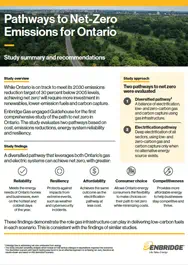About the study
While Ontario is on track to meet its 2030 emissions reduction target, achieving net-zero*Net zero means reducing GHG emissions to as close to zero as possible, then balancing any remaining emissions with an equivalent amount of carbon removal through environmental actions and innovative technology.
https://www.canada.ca/en/services/environment/weather/climatechange/climate-plan/net-zero-emissions-2050.html will require further actions. How will we effectively meet Ontario’s future energy needs while reducing emissions? How can we make sure energy is there when we need it, at the lowest cost? What investments are needed today, and what policies must be put in place to enable them?
Enbridge Gas engaged a consultant, Guidehouse, to assess the feasibility of two pathways to net zero. The study finds that, compared to an electrification pathway, a diversified pathway is the most practical way to achieve net zero emissions in Ontario while being more reliable, resilient and affordable.

Two pathways to net zero were evaluated
Electrification pathway
The study assessed two pathways based on emission reductions, energy system reliability, resiliency and cost. It also included a sensitivity analysis that looked at how various changes in assumptions impacted each scenario. The diversified scenario was the most optimal approach to reach net zero by 2050. Hybrid heating further optimizes the diversified scenario.
Key findings
Both pathways can achieve net zero by 2050
using low- and zero-carbon
natural gas
low- and zero-carbon gas
and carbon capture, using
gas infrastructure
Notable insights
A diversified pathway is further optimized with hybrid heating
Low-carbon gas and carbon capture are key to net zero
The electric system must be scaled up
Ontario’s gas distribution system should be leveraged
Safe bets Ontario must act on today
Regardless of the pathway chosen, there are actions that must be taken immediately to successfully reach net zero.

Maximize energy efficiency
Energy conservation is essential to success for any pathway to net zero.

Optimize and integrate energy system planning
Maintain reliable and resilient energy supply in Ontario by integrating gas and electric systems and planning. Hybrid heating is a good example of both systems working together.

Use carbon capture and storage (CCS)
CCS is needed to produce low-carbon hydrogen and to decarbonize hard-to-abate industrial processes.
Want to learn more? Download the materials.
Questions about the study?
Contact our Energy Transition team for further information.
*Enbridge Gas is addressing net-zero emissions from energy.











